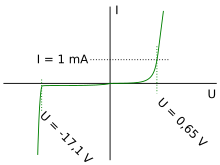Zener diode
The Zener diode is a heavily doped silicon diode that has been built to work in breakdown zones, named after its inventor Clarence Melvin Zener. The Zener diode is the essential part of almost constant voltage regulators regardless of large variations in mains voltage, load resistance and temperature.
They are sometimes wrongly called avalanche diodes, since they present behaviors similar to these, but the mechanisms involved are different. Furthermore, if the source voltage is lower than that of the diode, it cannot make its characteristic regulation.
Features
If a positive electrical voltage is applied to a Zener diode from the anode compared to a negative one at the cathode (forward bias), it takes on the characteristics of a basic rectifier diode (most cases), but if positive electrical voltage is supplied from cathode to negative at the anode (reverse bias), the diode will maintain a constant voltage. It does not act as a rectifier but as a voltage stabilizer
Varying the voltage V to values greater than the breakdown voltage of the Zener, Vz remains constant.
Its symbol is like that of a normal diode but it has two terminals on the sides. It should be borne in mind that the Zener diode, like any electronic device, has limitations and one of them is power dissipation. If its parameters are not taken into account, the component burns.
Operation
A conventional solid-state diode allows significant current if reverse-biased above its reverse breakdown voltage.
When the reverse bias breakdown voltage is exceeded, a conventional diode is subjected to high current due to avalanche breakdown. Unless this current is limited by the circuitry, the diode can be permanently damaged due to overheating.
A zener diode exhibits almost the same properties, except that the device is specially designed to have a low breakdown voltage, the so-called zener voltage. In contrast to the conventional device, a reverse-biased Zener diode exhibits controlled failure and allows current to maintain the voltage across the Zener diode near the Zener breakdown voltage.
For example, a diode with a zener breakdown voltage of 3.2 V has a voltage drop of almost 3.2 V over a wide range of reverse currents. The Zener diode is therefore ideal for applications such as generating a reference voltage (eg for an amplifier stage), or as a voltage stabilizer for low current applications.
Another mechanism that produces a similar effect is the avalanche effect as in the avalanche diode.
The two types of diodes are actually built the same way and both effects are present in diodes of this type. In silicon diodes up to about 5.6 volts, the Zener effect is the predominant effect and shows a marked negative temperature coefficient. Above 5.6 volts, the avalanche effect becomes predominant and exhibits a positive temperature coefficient.
In a 5.6V diode, the two effects occur together, and their temperature coefficients almost cancel each other, so the 5.6V diode is useful in temperature-critical applications. An alternative, used for voltage references that need to be highly stable over long periods of time, is to use a Zener diode with a temperature coefficient (CT) of +2 mV/°C (fault voltage of 6.2-6.3 V) connected in series with a forward-biased silicon diode (or a transistor BE junction) made on the same chip.
The forward-biased diode has a temperature coefficient of -2 mV/°C, which causes the temperature coefficients to cancel.
Modern manufacturing techniques have produced devices with voltages less than 5.6 V with negligible temperature coefficients, but as higher voltage devices are found, the temperature coefficient increases dramatically. A 75 V diode has 10 times the coefficient of a 12 V diode.
Zener and avalanche diodes, regardless of breakdown voltage, are generally marketed under the umbrella term "Zener Diode".
Below 5.6 V, where the Zener effect dominates, the voltage-current curve near breakdown is much more rounded, requiring more care in approaching your bias conditions. The voltage-current curve for Zeners above 5.6V (which is dominated by Avalanche), is much sharper at the time of breakdown.
Contenido relacionado
Elevator
Thermoionic valve
Computer cluster


